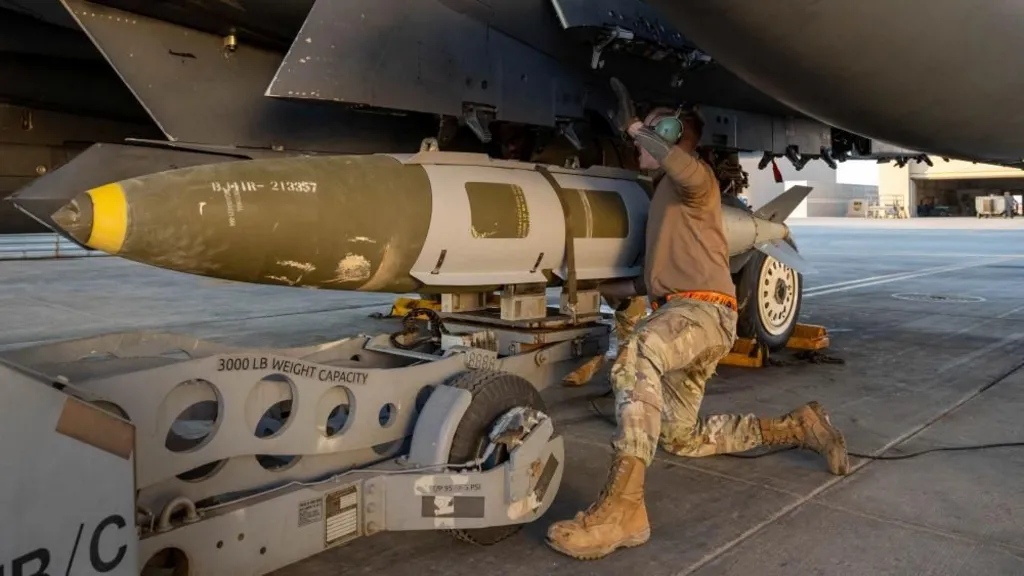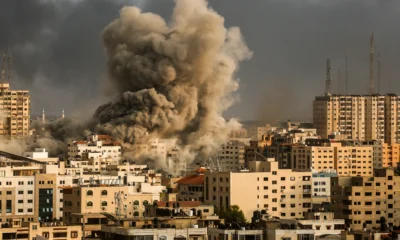Gaza
Israel says body of Lior Rudaeff has been returned from Gaza

The Israeli military says it has identified a body handed over from Gaza as that of Israeli-Argentinian Lior Rudaeff.
The 61-year-old was killed while attempting to defend Nir Yitzhak kibbutz during the Hamas attack on southern Israel on 7 October 2023 and his body was taken to Gaza by the Palestinian Islamic Jihad (PIJ) armed group, the military said.
PIJ said the body was found on Friday in Khan Younis in southern Gaza.
Hamas has now returned all 20 living hostages and 23 out of 28 deceased hostages under the first phase of a ceasefire deal that started on 10 October. Four of the five dead hostages still in Gaza are Israelis and one is Thai.
Israel has criticised Hamas for not yet returning all the bodies. Hamas says it is hard to find them under rubble.
PIJ is an armed group allied with Hamas. It took part in the 7 October attack and previously held some Israeli hostages.
The Hostages and Missing Families Forum, a campaign group, welcomed the return.
“Lior’s return provides some measure of comfort to a family that has lived with agonising uncertainty and doubt for over two years,” it said in a statement. “We will not rest until the last hostage is brought home.”
During the first phase of the US-brokered ceasefire deal, Israel freed 250 Palestinian prisoners in its jails and 1,718 detainees from Gaza.
Israel has also handed over the bodies of 300 Palestinians in exchange for the bodies of the 20 Israeli hostages returned by Hamas, along with those of three foreign hostages – one of them Thai, one Nepalese and one Tanzanian.
The parties also agreed to an increase of aid to the Gaza Strip, a partial withdrawal of Israeli forces, and a halt to fighting, although violence has flared up as both sides accused one another of breaching the deal.
Israel launched air strikes after accusing Hamas fighters of killing two of its soldiers on 19 October and of killing another soldier on 28 October. Hamas said it was unaware of clashes in the area of the first incident and had no connection to the second attack.
Israeli military actions have killed at least 241 people since the start of the ceasefire, according to the Hamas-run health ministry, whose figures are seen by the UN as reliable.
The Israeli military launched a campaign in Gaza in response to the 7 October 2023 attack, in which Hamas-led gunmen killed about 1,200 people in southern Israel and took 251 others hostage. All but one of the dead hostages still in Gaza were abducted in the attack.
At least 69,169 people have been killed by Israeli attacks in Gaza since then, the health ministry reported.
Gaza
US carries out ‘massive’ strike against IS in Syria

The US says its military has carried out a “massive strike” against the Islamic State group (IS) in Syria, in response to a deadly attack on American forces in the country.
The US Central Command (Centcom) said fighter jets, attack helicopters and artillery “struck more than 70 targets at multiple locations across central Syria”. Aircraft from Jordan were also involved.
It said the operation “employed more than 100 precision munitions” targeting known IS infrastructure and weapons sites.
President Donald Trump said “we are striking very strongly” against IS strongholds, following the 13 December IS ambush in the city of Palmyra in which two US soldiers and a US civilian interpreter were killed.
In a statement on X, Centcom – which directs American military operations in the Middle East, north-east Africa, central and southern Asia – said Operation Hawkeye Strike was launched at 16:00 Eastern Time (21:00 GMT) on Friday.
Centcom commander Admiral Brad Cooper said that the US “will continue to relentlessly pursue terrorists who seek to harm Americans and our partners across the region”.
Rami Abdel Rahman, the head of the Syrian Observatory for Human Rights (SOHR), told news agency AFP that “at least five members of the Islamic State group were killed” in eastern Syria’s Deir ez Zor province, including the leader of a cell responsible for drones in the area.
Petra, Jordan’s state-run news agency, announced the Royal Jordanian Air Force had participated in the strikes to “prevent extremist groups” from “threaten[ing] the security of Syria’s neighbours and the wider region”.
IS has not publicly commented. The BBC was unable to immediately verify the targets.
US Defence Secretary Pete Hegseth said the operation “is not the beginning of a war – it is a declaration of vengeance.
“If you target Americans – anywhere in the world – you will spend the rest of your brief, anxious life knowing the United States will hunt you, find you, and ruthlessly kill you.
“Today, we hunted and we killed our enemies. Lots of them. And we will continue,” the US defence secretary added.
Posting on Truth Social, President Trump said the US “is inflicting very serious retaliation, just as I promised, on the murderous terrorists responsible”.
He said the Syrian government was “fully in support”.
Centcom earlier said that the deadly attack in Palmyra was carried out by an IS gunman, who was “engaged and killed”.
Another three US soldiers were injured in the ambush, with a Pentagon official saying that it happened “in an area where the Syrian president does not have control.”
At the same time, the SOHR said the attacker was a member of the Syrian security forces.
No group has claimed responsibility for the attack, and the identity of the gunman has not been released.
In 2019, a US-backed alliance of Syrian fighters announced IS had lost the last pocket of territory in Syria it controlled, but since then the jihadist group has carried out some attacks.
The United Nations says the group still has between 5,000 and 7,000 fighters in Syria and Iraq.
US troops have maintained a presence in Syria since 2015 to help train other forces as part of a campaign against IS.
Syria has recently joined an international coalition to combat IS and has pledged to co-operate with the US.
In November, Syrian President Ahmed al-Sharaa – a former jihadist leader whose coalition forces toppled Bashar al-Assad’s regime in 2024 – met Trump at the White House, describing his visit as part of a “new era” for the two countries.
https://www.bbc.com/news/articles/c5yq7zzw618o
Taken From BBC News
Gaza
Heavy rains worsen conditions for displaced Gazans, UN warns

Heavy rains over the past week have compounded the already dire living conditions of the hundreds of thousands of displaced Palestinians in the Gaza Strip, UN agencies say.
Unicef spokesman Jonathan Crickx told the BBC that the weather overnight had been “horrendous”, with the rain so intense that he had seen up to 15cm (6in) of water on the ground near his office.
He said he was extremely concerned that children living in tents and makeshift shelters in wet clothing would succumb to hypothermia and other illnesses.
Gaza’s Hamas-run health ministry has said one baby has died from hypothermia and at least 11 other people have died in building collapses caused by the severe weather.
UN agencies have stepped up deliveries of tents, blankets and clothes since the Gaza ceasefire began nine weeks ago, but they have said there is still not enough aid getting in.
The UN and its partners estimate that almost 55,000 families have so far been affected by the rains, with their belongings and shelters damaged or destroyed.
More than 40 designated emergency shelters were severely flooded following downpours on Monday and Tuesday, forcing many people to relocate again.
“Last night was really horrendous for the families. The heavy rains were so intense that we could see from our office and guest house 10cm, 15cm (4-6in) of water at some point. And the winds were so strong,” Jonathan Crickx, chief of communications for Unicef State of Palestine, told the BBC’s Today programme on Wednesday.
“When I drove this morning, I could see that many, many people were trying with buckets to remove some of the water.”
He noted that most of the estimated one million people living in tents and makeshift shelters had been displaced many times during the two years of war between Israel and Hamas, and that they had no or very few changes of clothes.
“When I was seeing [children] this morning, their clothes were damp. I could see parents trying to dry some of the blankets they had. But it has been raining almost all of the time in the past four or five days, so it is extremely difficult to keep the children dry,” he said.
“With temperatures about 7C, 8C (45-46F) at night, we are extremely concerned about children getting sick or even worse, dying from hypothermia.”
Many tents were also at risk of being blown away or destroyed by the strong winds accompanying the rain because they were only made from a piece of tarpaulin or plastic sheeting nailed to a fragile wooden structure, he added.
Mr Crickx said Unicef had been able to bring in more aid during the ceasefire to help children cope with the harsh winter conditions, including 250,000 winter clothing kits, 600,000 blankets and 7,000 tents, but that it was not enough.
“We are working relentlessly to bring in that aid and to distribute it, but the scale of the needs is so immense that we still have thousands of people and children who are really suffering every night,” he warned.
Gaza’s health ministry said a two-week old boy named Mohammed Abu al-Khair had died of hypothermia on Monday, two days after he had been admitted to hospital and placed in intensive care. Another 11 people had so far died after the war-damaged buildings where they were sheltering collapsed, it added.
A spokesman for the Hamas-run Civil Defence agency, Mahmoud Bassal, put the death toll higher. He said in a video that a total of 17 people, including four children, had died because of building collapses and the cold.
He added that 17 residential buildings had collapsed completely because of the wind and rain and that another 90 buildings had collapsed partially.
On Tuesday, video footage showed first responders from the Civil Defence recovering the body of a man from the rubble of a building in Shati refugee camp, north-west of Gaza City. Its roof had collapsed suddenly, according to eyewitnesses.
“We call on the world to solve our problems and rebuild the territory so that people can have homes instead of being displaced and living in the streets,” said Ahmed al-Hosari, a relative of the man, told AFP news agency.
The International Committee of the Red Cross (ICRC) said the collapse of damaged buildings due to the severe weather conditions was “deeply concerning”.
It stressed the need for “increased and sustained humanitarian assistance to respond to urgent and long-term needs, including food, shelter and equipment for the repair of critical infrastructure”.
Cogat, the Israeli military body which controls Gaza’s border crossings, has dismissed claims of deliberate aid restrictions as “inconsistent with facts on the ground, and the ongoing co-ordination taking place daily”.
It says that between 600 and 800 lorries carrying humanitarian supplies enter Gaza daily, and that almost 310,000 tents and tarpaulins have been delivered since the start of the ceasefire, along with more than 1,800 lorry loads of warm blankets and clothing.
The UN says a total of 67,800 tents, 372,500 tarpaulins and 318,100 bedding items have been collected from crossings over the same period.
The second phase of the ceasefire between Israel and Hamas includes plans for the reconstruction of Gaza, along with post-war governance, the withdrawal of Israeli troops, and the disarmament of Hamas.
Last week, Israel’s prime minister said the second phase was close, with only the body of one dead Israeli hostage in Gaza still to be returned by Hamas as part of the first phase.
The war was triggered by the Hamas-led attack on southern Israel on 7 October 2023, in which about 1,200 people were killed and 251 others were taken hostage.
More than 70,600 people have been killed in Israeli attacks in Gaza since then, according to the territory’s health ministry.
Gaza
From Gaza to Bondi Beach: How Israel’s War Fuels Global Rage

Paris (Imran Y. CHOUDHRY) :- Former Press Secretary to the President, Former Press Minister to the Embassy of Pakistan to France, Former MD, SRBC Mr. Qamar Bashir analysis : On December 14, 2025, Australia was jolted out of its sense of safety. At Bondi Beach in Sydney, a space synonymous with openness, community, and peaceful coexistence, gunmen opened fire on members of the Jewish community gathered to celebrate Hanukkah. Eleven people were killed and many more injured. Families, children, and elders—people with no role in war, policy, or geopolitics—were turned into victims of terror.
The attack was immediately and rightly condemned by Australia and the world. There can be no ambiguity: the killing of civilians anywhere is criminal, immoral, and indefensible. No grievance, no ideology, no historical wound justifies such an act. The Jewish community in Australia, like Jewish communities everywhere, deserves safety, dignity, and protection.
Yet condemnation alone does not prevent recurrence. If the world wishes to stop such horrors from repeating, it must confront a harder truth: violence does not arise in isolation. It is shaped, amplified, and redirected by global political behavior—especially when power is exercised without accountability.
The Bondi Beach massacre occurred in a world already saturated with unresolved wars, mass civilian suffering, and a growing perception that international law is applied selectively. This perception—whether ignored or dismissed by those in power—has consequences. When pain is denied in one place, it does not disappear. It travels. It mutates. And it eventually erupts where the innocent live.
The Hamas attack of October 7, 2023, which killed Israeli civilians and took hostages, was universally condemned. That condemnation was justified. What followed, however, shattered moral balance. Israel’s military response in Gaza resulted in the deaths of tens of thousands of Palestinian civilians, the destruction of homes, hospitals, schools, and the deliberate deprivation of food, water, and medical aid. International legal institutions and humanitarian organizations warned that collective punishment and starvation had become tools of war.
This matters not to excuse terrorism or antisemitism—both are crimes—but to understand how unchecked state violence creates global insecurity. When a state presents itself as above scrutiny, when it dismisses civilian deaths as necessary or inevitable, it sends a message to the world that human life is conditional. That message does not stay confined to Gaza. It seeps into streets, minds, and communities across continents.
The Jewish community worldwide has increasingly been placed in an impossible position. Jews in Australia, Europe, or North America do not command armies, blockade borders, or authorize bombardments. Yet they increasingly find themselves vulnerable to backlash generated by actions taken by a government thousands of miles away. This conflation is unjust, dangerous, and morally wrong—but it is fueled by the refusal of powerful leaders to acknowledge the global consequences of their conduct.
This refusal was starkly illustrated in the aftermath of the Bondi Beach killings. Instead of engaging in self-reflection or acknowledging how Israel’s actions in Gaza have heightened global tensions and endangered Jewish communities abroad, Israeli Prime Minister Benjamin Netanyahu publicly criticized the Australian government, accusing it of failing to provide adequate security to the Jewish community.
In doing so, Netanyahu acted not as a statesman grappling with consequences, but as if he were a ruler passing judgment on sovereign nations—assigning blame outward while absolving himself entirely. There was no acknowledgment that the relentless violence in Gaza, the images of starving children, and the dismissal of international law have contributed to an environment in which rage is exported globally. There was no recognition that leadership carries responsibility not only for battlefield outcomes, but for the safety of one’s people everywhere.
By placing the burden solely on Australia’s security apparatus, Netanyahu effectively treated the Bondi Beach massacre as an isolated policing failure—rather than as a symptom of a wider moral and political breakdown. This posture is not only arrogant; it is dangerous. It ignores the simple reality that actions taken in the Middle East now reverberate instantly across the world.
A similar warning emerged just one day earlier, on December 13, 2025, in Palmyra, Syria. A lone suspected Islamic State gunman attacked a convoy of U.S. and Syrian partner forces during a key leader engagement. The assault killed two U.S. Army soldiers and a civilian interpreter, and wounded three others. Partner forces killed the attacker at the scene. President Donald Trump vowed serious retaliation.
That attack, like Bondi Beach, underscored the same truth: wars fought far from home do not remain distant. They return—sometimes as direct attacks, sometimes as unpredictable consequences. Soldiers, interpreters, and civilians pay the price for conflicts whose political roots remain unresolved.
This reality struck even closer to home in Washington, D.C., where a lone Afghan gunman killed one U.S. soldier and critically wounded another. His act was criminal and indefensible. But it was also a reminder that decades of war leave behind trauma and grievance that do not end with troop withdrawals. When conflicts are managed through force rather than resolution, the aftershocks linger in human lives.
Today, the same pattern threatens to repeat itself in the Western Hemisphere. Tensions between the United States and Venezuela, and increasingly involving Colombia, are escalating. Once again, familiar language is resurfacing—delegitimization, sanctions, pressure, and whispers of regime change. The narrative being constructed against Venezuela echoes the one once built against Iraq: moral urgency, existential threat, inevitability of action.
We know how that story ended. Iraq was destabilized. Libya collapsed. Syria fractured. The Middle East was turned upside down. Millions were displaced. Extremism flourished. And the consequences spilled into Europe, North America, and beyond.
Venezuela may be weaker than the United States militarily, but modern conflict teaches a clear lesson: retaliation does not strike power centers; it strikes soft targets. It does not reach presidents; it reaches soldiers, worshippers, commuters, and children. Innocent Americans—both civilians and service members—become exposed to the revenge of those whose loved ones were killed far away.
This is not justification. It is historical reality. Violence creates memory. Memory creates resentment. Resentment seeks release—often against those least responsible.
The tragedies at Bondi Beach, in Palmyra, in Washington, and the looming risks in Venezuela and Colombia all point to the same conclusion: when leaders refuse accountability, insecurity becomes global. No border, no ocean, no alliance can contain the consequences.
The only alternative is restraint, diplomacy, and genuine multilateral engagement. Institutions like the United Nations exist to prevent this chain reaction—to replace unilateral force with collective responsibility. They are imperfect, but bypassing them guarantees repetition of failure.
If humanity continues to normalize collective punishment, regime-change wars, and selective morality, the violence will keep returning—again and again—against people who never chose these conflicts. Peace is not a moral luxury. It is a strategic necessity.
Only by choosing introspection over arrogance, law over impunity, and dialogue over domination can the world hope to prevent the next Bondi Beach—and the next innocent life lost to a war they never owned.
-

 Europe News10 months ago
Europe News10 months agoChaos and unproven theories surround Tates’ release from Romania
-

 American News10 months ago
American News10 months agoTrump Expels Zelensky from the White House
-

 American News10 months ago
American News10 months agoTrump expands exemptions from Canada and Mexico tariffs
-

 American News10 months ago
American News10 months agoZelensky bruised but upbeat after diplomatic whirlwind
-

 Art & Culture10 months ago
Art & Culture10 months agoThe Indian film showing the bride’s ‘humiliation’ in arranged marriage
-

 Art & Culture10 months ago
Art & Culture10 months agoInternational Agriculture Exhibition held in Paris
-

 Pakistan News6 months ago
Pakistan News6 months agoComprehensive Analysis Report-The Faranian National Conference on Maritime Affairs-By Kashif Firaz Ahmed
-

 Politics10 months ago
Politics10 months agoUS cuts send South Africa’s HIV treatment ‘off a cliff’



















